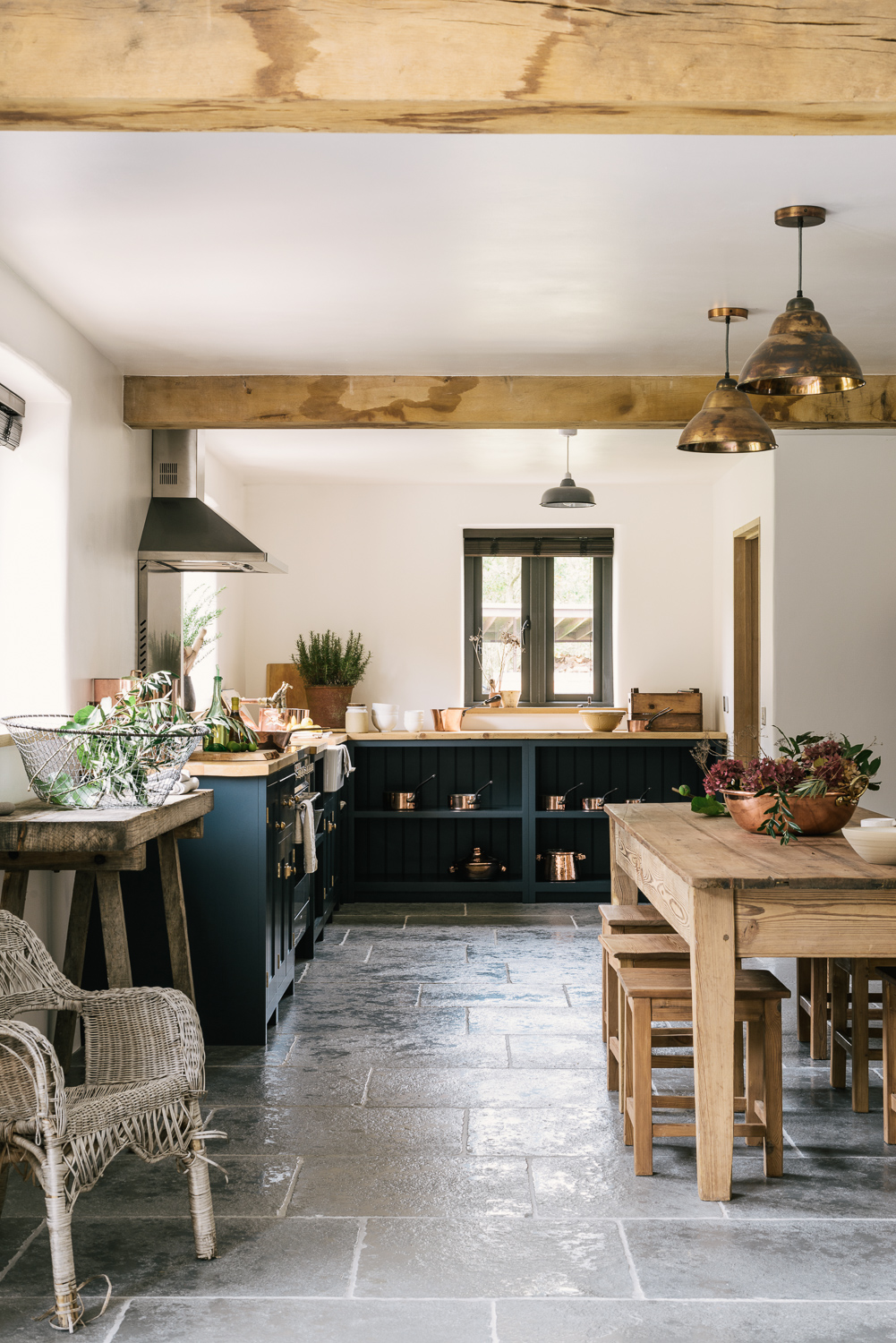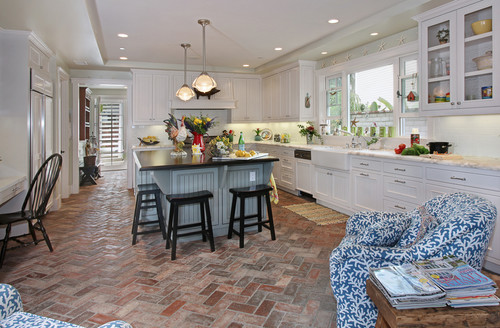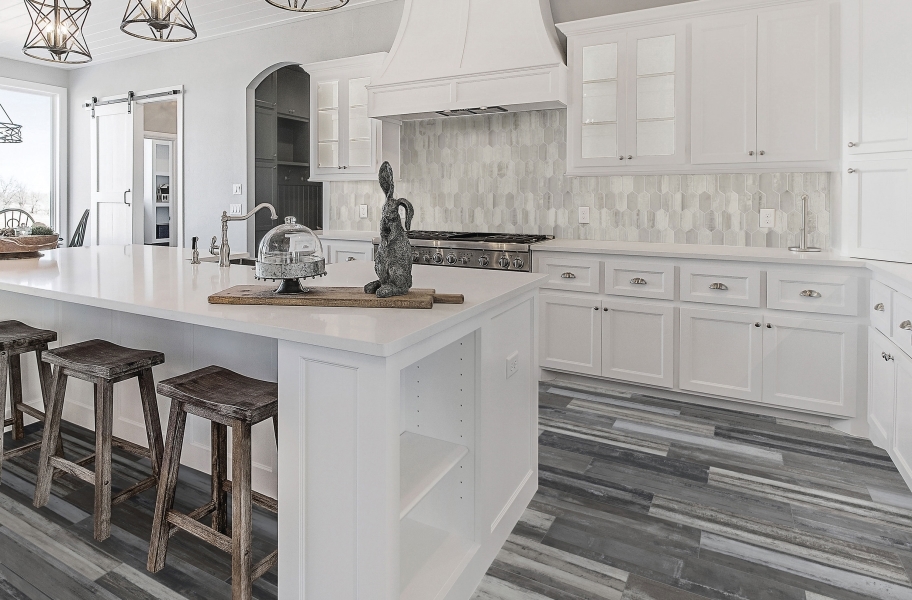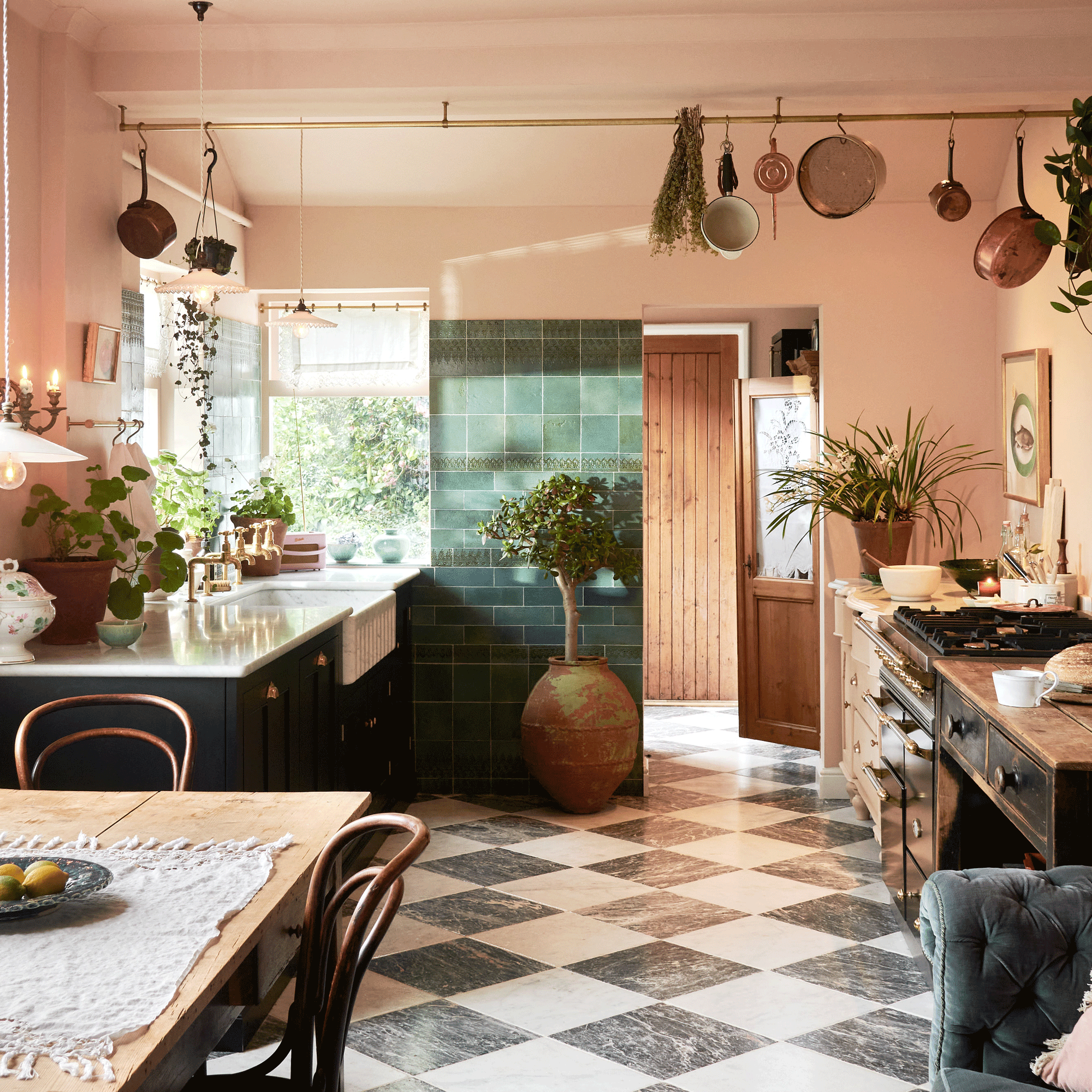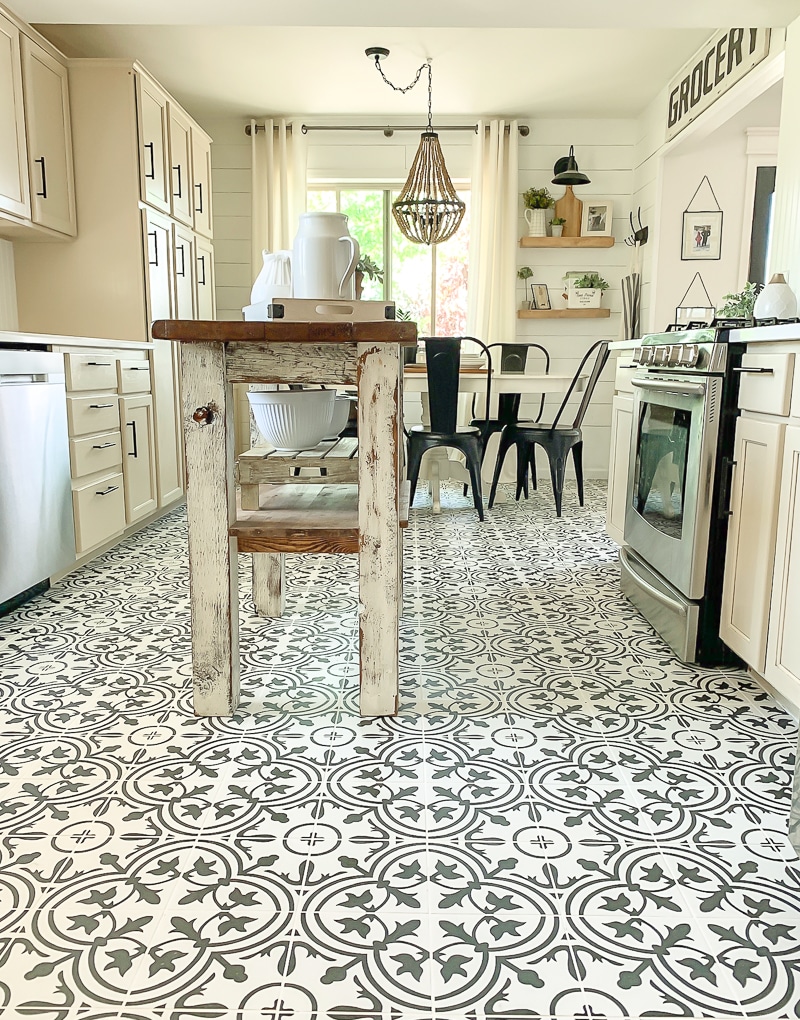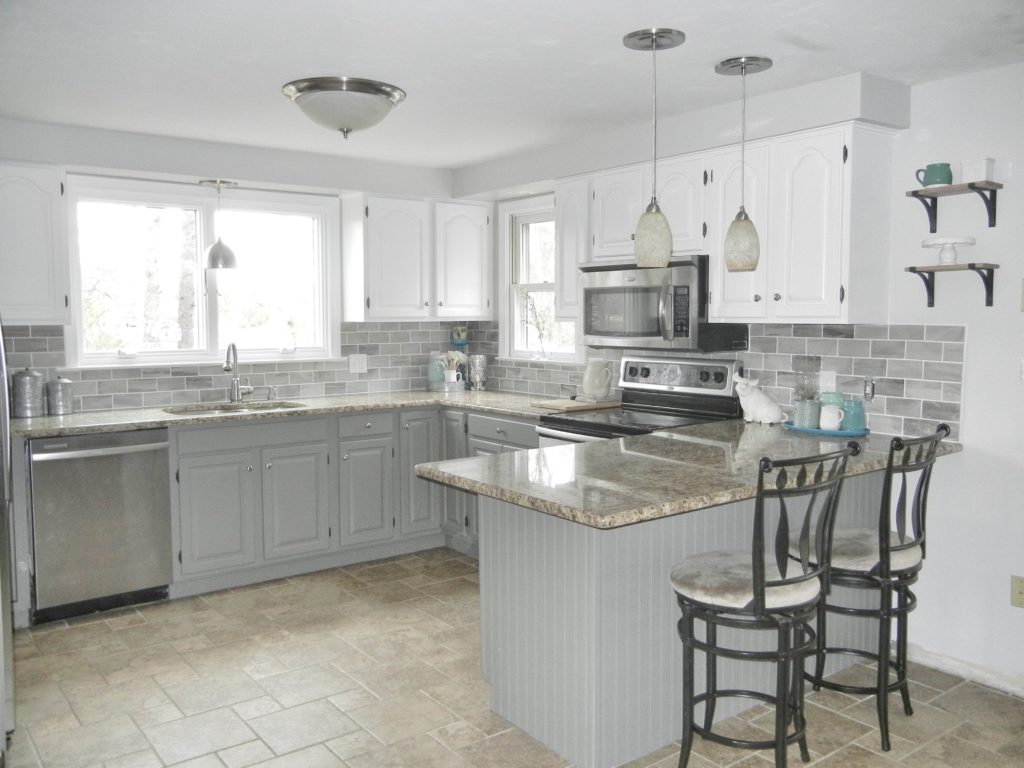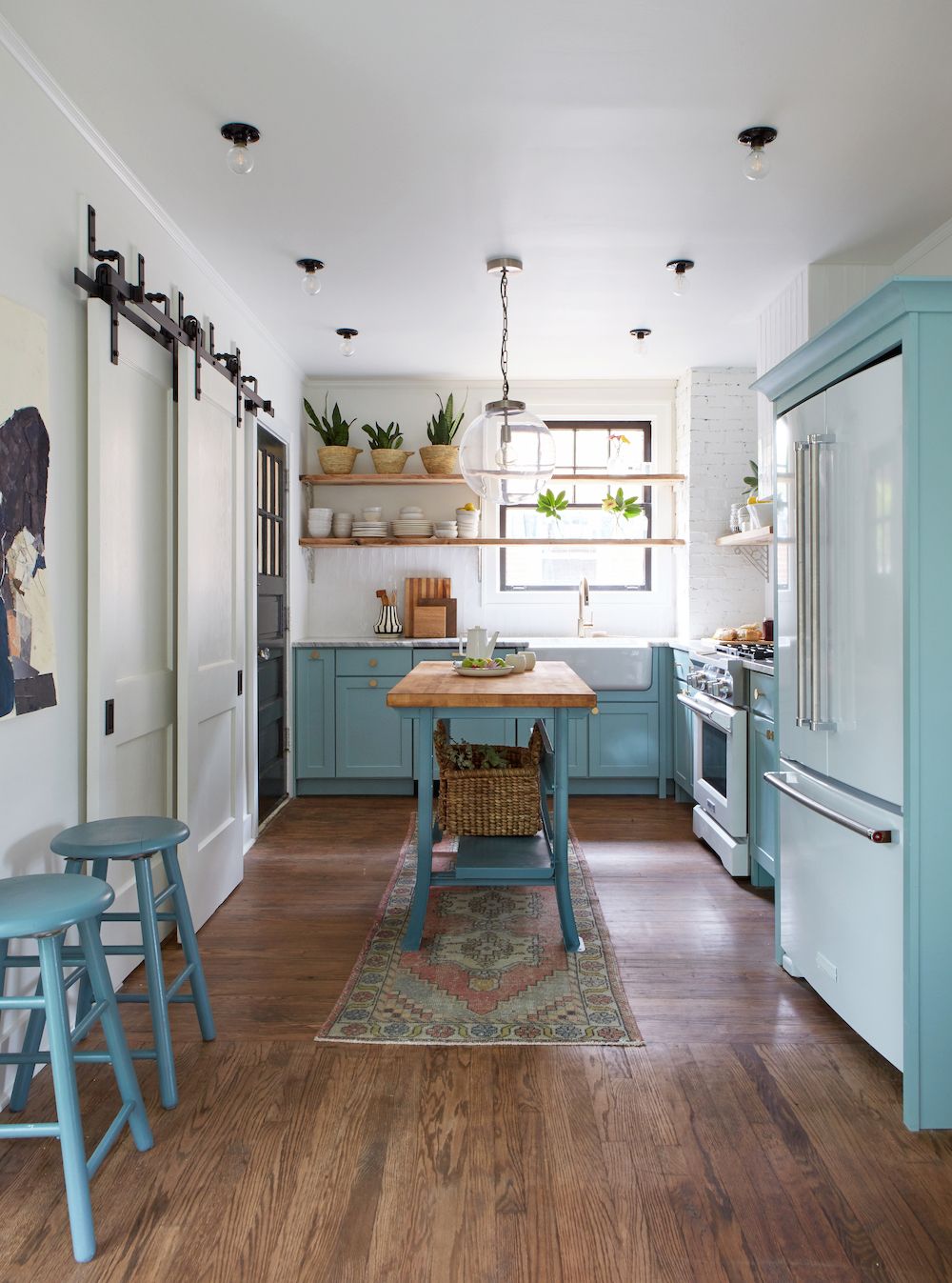Farmhouse kitchens evoke a sense of warmth, tradition, and simplicity, all while blending rustic charm with modern amenities. The choice of flooring in a farmhouse kitchen is critical as it serves as the foundation for this harmonious balance. From classic hardwood to versatile tile, the flooring you select can significantly impact the overall aesthetic and functionality of the space. Here’s an in-depth exploration of various farmhouse kitchen flooring ideas to help you create a kitchen that embodies the timeless allure of the countryside.
Hardwood Flooring: A Classic Choice
Why Hardwood Remains a Favorite
Hardwood flooring continues to be a top choice for farmhouse kitchens due to its timeless appeal and natural beauty. It adds a warm, rustic touch that complements the farmhouse aesthetic perfectly. The unique grain patterns and natural variations in color found in hardwood planks bring character and charm, making each floor unique.
One of the significant advantages of hardwood flooring is its durability. Properly maintained hardwood can last for decades, making it a practical investment for your kitchen. Moreover, it can be refinished multiple times, allowing you to restore its original beauty if it becomes worn or scratched.
Hardwood also offers versatility in terms of design. It can be stained in various shades, from light oak to dark walnut, to match your kitchen’s color scheme. Whether your farmhouse kitchen leans toward traditional or modern styles, hardwood can adapt to fit your vision.
However, hardwood does have some drawbacks. It is susceptible to water damage, making it less ideal for kitchens that experience heavy spills or moisture. Careful maintenance and immediate attention to spills are necessary to preserve its integrity.
In terms of installation, hardwood can be more labor-intensive and costly compared to other flooring options. It’s crucial to hire experienced professionals to ensure a proper installation, especially in a kitchen where precision is key.
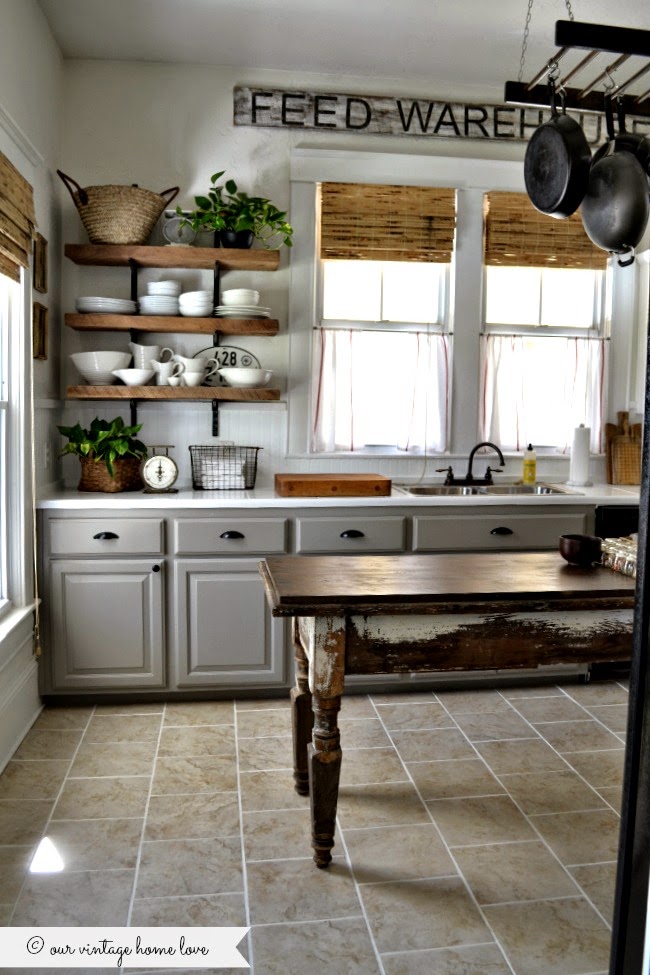
Types of Hardwood Suitable for Farmhouse Kitchens
When selecting hardwood for your farmhouse kitchen, the species of wood you choose will impact both the look and performance of your floor. Oak is a popular choice for its durability and attractive grain patterns. It’s available in a variety of finishes, allowing for customization to suit your kitchen’s design.
Maple is another excellent option, known for its smooth grain and lighter color, which can brighten up your kitchen space. It’s a bit harder than oak, making it resistant to scratches and dents.
For a more rustic look, consider hickory or pine. Hickory offers a striking contrast with its rich color variations, while pine, being softer, gives a more weathered and antique appearance over time. Pine floors can develop a patina that enhances the farmhouse charm as they age.
Walnut, although on the pricier side, provides a luxurious and elegant look with its deep, rich tones and intricate grain patterns. It’s ideal for creating a sophisticated farmhouse kitchen.
Reclaimed wood is also gaining popularity for its sustainability and unique history. Using salvaged wood from old barns or factories can add an authentic vintage touch to your kitchen floor, making it a conversation piece.
Maintaining Hardwood Floors in the Kitchen
Maintaining hardwood floors in a kitchen requires a proactive approach to keep them looking their best. Regular sweeping or vacuuming is essential to remove dirt and debris that can cause scratches. Use a microfiber mop with a damp, not wet, cloth for routine cleaning.
Spills should be wiped up immediately to prevent water damage. Consider using mats or rugs in high-traffic areas and near sinks to protect the wood from moisture and heavy use. These can also add a decorative element to your kitchen.
Refinishing your hardwood floors periodically will help maintain their appearance and extend their lifespan. This process involves sanding down the surface and applying a new finish, which can remove scratches and revive the wood’s natural luster.
Avoid using harsh chemicals or abrasive cleaning tools on hardwood floors, as these can damage the finish. Instead, opt for cleaning products specifically designed for hardwood.
It’s also important to monitor the humidity levels in your kitchen, as wood can expand and contract with changes in humidity. Using a humidifier or dehumidifier as needed can help maintain a stable environment for your floors.
Cost Considerations for Hardwood Flooring
Hardwood flooring can be a significant investment, with costs varying based on the type of wood, finish, and installation method. On average, expect to pay between $6 to $12 per square foot for materials, with additional costs for installation, which can range from $3 to $8 per square foot.
Prefinished hardwood tends to be more expensive than unfinished options, but it offers the advantage of quicker installation and immediate usability. Reclaimed wood, while more affordable in some cases, may require additional preparation and installation costs.
Consider the long-term value of hardwood when evaluating costs. Its durability and ability to be refinished can provide a good return on investment, making it a worthwhile option for those seeking a timeless and lasting flooring solution.
Budgeting for hardwood should also include potential costs for maintenance and refinishing over the years. Factoring in these aspects can help you make a more informed decision that aligns with your financial plan.
Conclusion on Hardwood Flooring
Hardwood flooring embodies the quintessential farmhouse charm with its natural beauty, durability, and adaptability. While it requires careful maintenance and can be a significant investment, its ability to enhance the aesthetics and value of your kitchen makes it a compelling choice. Whether you prefer the classic appeal of oak or the rustic allure of reclaimed wood, hardwood can provide the foundation for a welcoming and stylish farmhouse kitchen.
Tile Flooring: Durable and Versatile
Advantages of Tile in Farmhouse Kitchens
Tile flooring is an excellent choice for farmhouse kitchens, offering a blend of durability, versatility, and ease of maintenance. Unlike hardwood, tile is highly resistant to water and stains, making it ideal for kitchen environments prone to spills and splashes.
Tiles come in a wide range of materials, including ceramic, porcelain, and stone, allowing for diverse design options. They can mimic the appearance of wood or natural stone, providing the rustic look desired in a farmhouse kitchen while offering the practical benefits of tile.
One of the primary advantages of tile flooring is its durability. It can withstand heavy foot traffic, making it suitable for busy kitchens. Tiles are also resistant to scratches and dents, maintaining their appearance over time even in high-activity areas.
Maintenance for tile floors is straightforward. Regular sweeping and mopping keep them clean, and they don’t require the same level of care as hardwood or other sensitive materials. This ease of maintenance makes the tile a convenient option for those seeking a low-maintenance flooring solution.
Tile flooring is also a versatile choice in terms of design. From simple, solid-color tiles to intricate patterns and textures, the possibilities are nearly endless. You can create a classic farmhouse look with neutral tones or add a touch of modern flair with bold, patterned tiles.
Types of Tile Suitable for Farmhouse Kitchens
Several types of tiles are particularly well-suited for farmhouse kitchens, each offering unique benefits and aesthetic qualities. Ceramic tiles are popular for their affordability and versatility. They come in a wide variety of colors, shapes, and sizes, allowing for creative and personalized designs.
Porcelain tiles are known for their durability and resistance to moisture. They are a bit more expensive than ceramic but offer superior performance in wet areas, making them a practical choice for kitchen floors. Porcelain tiles can also mimic the appearance of natural stone or wood, providing a rustic look without the associated maintenance.
Natural stone tiles, such as slate, travertine, and marble, bring an authentic, earthy feel to farmhouse kitchens. Slate, with its rich, textured surface, adds a rugged, rustic charm. Travertine offers a more refined, classic look with its smooth surface and warm tones. Marble, although higher in maintenance, can provide a luxurious and elegant appearance.
Cement tiles have become increasingly popular in farmhouse kitchens for their unique patterns and vibrant colors. They can create a striking focal point and add a touch of artistic flair to the space.
Terracotta tiles are another option that adds warmth and character. Their reddish-brown hues and natural imperfections enhance the farmhouse aesthetic, giving the kitchen a cozy and inviting feel.
Installing Tile Flooring
Installing tile flooring requires careful planning and execution to ensure a long-lasting and visually appealing result. Proper preparation of the subfloor is essential. It must be clean, level, and free from any moisture issues that could compromise the installation.
The layout of the tiles should be planned meticulously, especially if using patterned or large-format tiles. Dry-laying the tiles before applying adhesive can help visualize the final look and make necessary adjustments.
Grout lines play a crucial role in the overall appearance of the tile floor. Choosing the right grout color can enhance the design, either by blending seamlessly with the tiles or providing a contrasting accent. Sealing the grout is also important to prevent staining and maintain the floor’s cleanliness.
Professional installation is often recommended for tile flooring, particularly for large or complex projects. Skilled installers can ensure that the tiles are laid evenly, and that grout lines are consistent, contributing to a polished and professional finish.
For those considering DIY installation, smaller projects or simpler designs can be manageable with the right tools and preparation. However, it’s essential to follow best practices and guidelines to achieve a satisfactory result.
Maintenance Tips for Tile Flooring
Maintaining tile flooring in a farmhouse kitchen is relatively straightforward. Regular sweeping or vacuuming helps remove dirt and debris that can scratch the surface. A damp mop with a mild cleaning solution is sufficient for routine cleaning.
It’s crucial to address spills promptly to prevent staining, especially on natural stone tiles, which can be more porous. Using mats or rugs in high-traffic areas and near sinks can provide additional protection.
Sealing the grout periodically is recommended to prevent it from absorbing dirt and stains. This process helps maintain the grout’s appearance and makes cleaning easier. Stone tiles may also require sealing to protect against moisture and stains.
Avoid using abrasive cleaners or tools on tile floors, as these can damage the surface or grout. Instead, opt for products specifically designed for tile cleaning.
For tiles that develop stains or stubborn dirt, using a soft brush and a gentle cleaner can help remove these without damaging the tiles. Regularly inspecting the tiles and grout for any signs of wear or damage can help you address issues promptly and keep your floor in top condition.
Conclusion on Tile Flooring
Tile flooring offers a practical and versatile solution for farmhouse kitchens, combining durability, ease of maintenance, and a wide range of design options. Whether you prefer the rustic appeal of natural stone or the modern versatility of porcelain, tile can meet the demands of a busy kitchen while contributing to the overall farmhouse aesthetic. With proper installation and maintenance, tile flooring can provide a beautiful and functional foundation for your farmhouse kitchen.
Vinyl and Laminate Flooring: Budget-Friendly Alternatives
Benefits of Vinyl and Laminate Flooring
Vinyl and laminate flooring are popular choices for farmhouse kitchens, especially for those looking for budget-friendly alternatives to hardwood or tile. These materials offer a balance of affordability, durability, and aesthetic appeal, making them suitable for a variety of kitchen designs.
Vinyl flooring is known for its water resistance, making it a practical choice for kitchens. It’s available in sheets, tiles, or planks, with designs that can mimic the appearance of wood, stone, or ceramic. Modern vinyl offers improved durability and can withstand heavy foot traffic, spills, and stains, making it an ideal choice for busy kitchens.
Laminate flooring, on the other hand, is composed of a high-density fiberboard core with a photographic layer that replicates the look of natural materials. It’s topped with a protective wear layer that adds durability and resistance to scratches and moisture. Laminate can closely resemble hardwood or stone, providing a high-end look at a fraction of the cost.
Both vinyl and laminate flooring are relatively easy to install, often featuring click-lock systems that allow for a floating floor installation. This can make them a suitable option for DIY enthusiasts or those looking to save on installation costs.
Vinyl Flooring Options for Farmhouse Kitchens
Vinyl flooring comes in various formats, each with its unique advantages. Luxury vinyl planks (LVP) and luxury vinyl tiles (LVT) are popular for their ability to mimic the look of natural wood or stone. They offer realistic textures and patterns, enhancing the farmhouse aesthetic while providing the practical benefits of vinyl.
Sheet vinyl is another option, available in large rolls that can cover the entire floor with minimal seams. It’s a cost-effective solution that provides a smooth, waterproof surface, making it ideal for kitchens. Sheet vinyl comes in a wide range of designs, from classic wood and stone patterns to modern geometric styles.
Vinyl tiles offer flexibility in design and installation. They can be arranged in various patterns, such as herringbone or checkerboard, allowing for creative and personalized flooring designs. Some vinyl tiles are peel-and-stick, simplifying the installation process.
Rigid core vinyl is a newer innovation that combines the durability of vinyl with a rigid core for added stability. It offers a more realistic appearance and improved resistance to dents and damage, making it a durable choice for high-traffic kitchen areas.
Laminate Flooring for a Rustic Look
Laminate flooring is a cost-effective alternative that can replicate the appearance of hardwood or stone without the associated maintenance. It’s available in a variety of finishes and textures, including hand-scraped, distressed, and embossed designs that add a rustic touch to farmhouse kitchens.
Laminate planks can mimic the look of various wood species, such as oak, maple, or hickory, providing flexibility in achieving the desired farmhouse style. They can also replicate the appearance of natural stone or ceramic tiles, offering diverse design options.
One of the benefits of laminate flooring is its ease of installation. Many laminate products feature a click-lock system that allows for a floating floor installation, eliminating the need for adhesives or nails. This can make it a convenient option for DIY projects.
In terms of maintenance, laminate is relatively easy to care for. Regular sweeping and occasional damp mopping are sufficient to keep it clean. However, it’s important to avoid excessive moisture, as laminate can be susceptible to water damage.
Laminate flooring is also a durable choice, with a protective wear layer that resists scratches and stains. This makes it suitable for kitchens that experience heavy foot traffic and activity.
Considerations for Vinyl and Laminate Flooring
When choosing vinyl or laminate flooring for your farmhouse kitchen, there are several factors to consider. While both materials offer affordability and ease of maintenance, they may not provide the same level of durability or aesthetic appeal as hardwood or tile.
Vinyl flooring, particularly lower-end options, can be prone to dents and scratches, especially in high-traffic areas. It’s essential to select high-quality vinyl products that offer enhanced durability and resistance to wear.
Laminate flooring, while durable, can be susceptible to water damage if exposed to excessive moisture. It’s crucial to clean up spills promptly and avoid using wet mops. Some laminate products are more water-resistant than others, so choosing a product designed for kitchen use can help mitigate this issue.
Both vinyl and laminate can be less forgiving than other materials when it comes to installation. Uneven subfloors or improper installation can lead to issues such as buckling or gaps. Ensuring a smooth, level subfloor and following manufacturer guidelines can help achieve a successful installation.
Conclusion on Vinyl and Laminate Flooring
Vinyl and laminate flooring offer practical, budget-friendly alternatives for farmhouse kitchens, combining affordability with durability and aesthetic versatility. Whether you prefer the realistic appearance of luxury vinyl or the rustic charm of laminate, these materials can provide a stylish and functional foundation for your kitchen. With proper selection and maintenance, vinyl and laminate flooring can deliver a durable and attractive flooring solution that complements your farmhouse kitchen design.
Natural Stone Flooring: Rustic Elegance
The Appeal of Natural Stone in Farmhouse Kitchens
Natural stone flooring brings a sense of rustic elegance to farmhouse kitchens, offering a unique blend of natural beauty, durability, and timeless appeal. Each stone tile is distinct, featuring variations in color, texture, and pattern that add character and depth to the floor.
Stone flooring is known for its durability and ability to withstand heavy use. It’s an excellent choice for high-traffic areas, providing a long-lasting and resilient surface that can handle the demands of a busy kitchen. Stone also has a natural ability to keep cool, making it comfortable underfoot, especially in warmer climates.
The natural variations in stone tiles contribute to a unique and authentic look, enhancing the farmhouse aesthetic. Whether you prefer the rugged texture of slate or the smooth elegance of marble, natural stone can add a touch of sophistication and charm to your kitchen.
Types of Natural Stone for Farmhouse Kitchens
Several types of natural stone are well-suited for farmhouse kitchens, each offering distinct characteristics and aesthetic qualities. Slate is a popular choice for its rich, earthy tones and textured surface. It adds a rugged, rustic feel to the kitchen and is highly durable, making it suitable for high-traffic areas.
Travertine is another excellent option, known for its warm, neutral colors and smooth surface. It provides a classic and refined look, enhancing the elegance of the farmhouse style. Travertine’s natural pores can be filled or left unfilled, depending on the desired appearance.
Marble offers a luxurious and sophisticated look with its smooth, polished surface and striking veining patterns. While higher in maintenance, marble can create a stunning focal point in the kitchen and add a touch of opulence.
Limestone, with its soft, natural colors and subtle textures, provides a more understated and elegant look. It’s a versatile option that can complement both traditional and modern farmhouse designs.
Granite, although more commonly used for countertops, can also be used for flooring. It offers unparalleled durability and a wide range of colors and patterns, making it a practical and visually appealing choice.
Installing Natural Stone Flooring
Installing natural stone flooring requires careful preparation and attention to detail. Proper preparation of the subfloor is essential to ensure a stable and level surface. The subfloor must be clean, dry, and free from any imperfections that could affect the installation.
The layout of the stone tiles should be planned meticulously, especially if using tiles with significant color or pattern variations. Dry-laying the tiles before installation can help achieve a balanced and visually appealing design.
Stone tiles are typically installed using a thin-set mortar, which provides a strong bond and ensures the tiles stay in place. Grout lines should be consistent and carefully chosen to complement the stone. Sealing the grout is important to prevent staining and maintain the cleanliness of the floor.
Sealing the stone tiles themselves is also recommended, particularly for more porous stones like travertine or limestone. This helps protect the surface from stains and moisture, preserving the stone’s appearance and longevity.
Professional installation is often recommended for natural stone flooring, especially for larger or more complex projects. Experienced installers can ensure that the tiles are laid evenly and that the installation is completed to a high standard.
Maintaining Natural Stone Floors
Maintaining natural stone floors in a farmhouse kitchen involves regular cleaning and periodic sealing to protect the surface and preserve its beauty. Regular sweeping or vacuuming helps remove dirt and debris that can scratch the surface. Using a damp mop with a pH-neutral cleaner is recommended for routine cleaning.
It’s important to avoid using acidic or abrasive cleaners on natural stone, as these can damage the surface or cause etching. Instead, use cleaning products specifically designed for natural stone.
Sealing the stone periodically is essential to protect it from stains and moisture. The frequency of sealing depends on the type of stone and the amount of traffic it receives. High-traffic areas may require more frequent sealing.
Spills should be wiped up promptly to prevent staining, especially for more porous stones. Using mats or rugs in high-traffic areas and near sinks can provide additional protection and help prevent wear and tear.
Regularly inspecting the stone tiles for any signs of damage or wear can help you address issues promptly and keep your floor looking its best. If necessary, professional stone restoration services can help restore the surface and remove any stains or etching.
Conclusion on Natural Stone Flooring
Natural stone flooring offers a timeless and elegant option for farmhouse kitchens, combining durability with the unique beauty of natural materials. Whether you prefer the rustic texture of slate or the refined elegance of marble, natural stone can enhance the farmhouse aesthetic and provide a long-lasting and visually appealing foundation for your kitchen. With proper installation and maintenance, natural stone flooring can be a stunning and durable choice that complements your farmhouse kitchen design.
Brick Flooring: Rustic Charm and Durability
The Unique Appeal of Brick Flooring
Brick flooring brings a distinctive and rustic charm to farmhouse kitchens, offering a warm and inviting aesthetic that complements the farmhouse style. The rich, earthy tones and textured surface of brick create a cozy and timeless look that enhances the overall character of the kitchen.
One of the key advantages of brick flooring is its durability. Brick is highly resistant to wear and tear, making it suitable for high-traffic areas. It can withstand heavy use and is less likely to show signs of wear, making it a practical choice for busy kitchens.
Brick flooring also offers excellent thermal properties, helping to keep the kitchen cool in the summer and warm in the winter. Its natural insulation properties contribute to a comfortable and energy-efficient environment.
The unique texture and color variations found in brick add depth and visual interest to the floor. Each brick is distinct, contributing to a one-of-a-kind look that enhances the farmhouse aesthetic.
Types of Brick Flooring for Farmhouse Kitchens
Brick flooring comes in various styles and formats, each offering distinct characteristics and aesthetic qualities. Traditional brick pavers are a popular choice for their classic appearance and durability. They can be laid in various patterns, such as herringbone or basketweave, to create a visually appealing design.
Reclaimed brick offers a vintage look with its weathered appearance and historical character. Using salvaged bricks from old buildings or roads can add an authentic and unique touch to your farmhouse kitchen, making it a focal point and conversation piece.
Thin brick veneer is another option, providing the look of traditional brick with a thinner profile. It’s lighter and easier to install, making it suitable for renovation projects or areas where full-sized bricks may be impractical.
Brick tiles are also available, offering the appearance of brick with the convenience of tile installation. They come in various sizes and styles, allowing for flexibility in design and application.
In terms of color, brick flooring is available in a range of hues, from warm reds and browns to cool grays and whites. Choosing the right color can help complement your kitchen’s color scheme and overall design.
Installing Brick Flooring
Installing brick flooring requires careful planning and preparation to ensure a successful and visually appealing result. The subfloor must be properly prepared, clean, and leveled to support the weight and structure of the bricks.
The layout of the bricks should be planned meticulously, especially if using patterned designs. Dry-laying the bricks before applying adhesive or mortar can help visualize the final look and make necessary adjustments.
Brick flooring is typically installed using a mortar bed or adhesive, depending on the type of bricks and the installation method. Grout lines should be consistent and carefully chosen to complement the bricks. Sealing the grout is important to prevent staining and maintain the cleanliness of the floor.
Sealing the bricks themselves is also recommended, particularly for more porous or reclaimed bricks. This helps protect the surface from stains and moisture, preserving the bricks’ appearance and longevity.
Professional installation is often recommended for brick flooring, especially for larger or more complex projects. Experienced installers can ensure that the bricks are laid evenly and that the installation is completed to a high standard.
Maintaining Brick Floors
Maintaining brick floors in a farmhouse kitchen involves regular cleaning and periodic sealing to protect the surface and preserve its beauty. Regular sweeping or vacuuming helps remove dirt and debris that can scratch the surface. Using a damp mop with a mild cleaner is recommended for routine cleaning.
It’s important to avoid using acidic or abrasive cleaners on brick, as these can damage the surface or cause etching. Instead, use cleaning products specifically designed for brick or natural stone.
Sealing the bricks periodically is essential to protect them from stains and moisture. The frequency of sealing depends on the type of bricks and the amount of traffic they receive. High-traffic areas may require more frequent sealing.
Spills should be wiped up promptly to prevent staining, especially for more porous or reclaimed bricks. Using mats or rugs in high-traffic areas and near sinks can provide additional protection and help prevent wear and tear.
Regularly inspecting the bricks for any signs of damage or wear can help you address issues promptly and keep your floor looking its best. If necessary, professional restoration services can help restore the surface and remove any stains or damage.
Conclusion on Brick Flooring
Brick flooring offers a unique and rustic option for farmhouse kitchens, combining durability with the warm and inviting charm of natural materials. Whether you prefer the classic look of traditional brick pavers or the vintage appeal of reclaimed bricks, brick flooring can enhance the farmhouse aesthetic and provide a long-lasting and visually appealing foundation for your kitchen. With proper installation and maintenance, brick flooring can be a stunning and durable choice that complements your farmhouse kitchen design.
Concrete Flooring: Modern Rustic Appeal
The Versatility of Concrete Flooring
Concrete flooring has become increasingly popular in farmhouse kitchens for its modern rustic appeal and versatility. It offers a sleek and contemporary look while retaining the natural, earthy qualities that complement the farmhouse aesthetic. Concrete can be customized in various ways, making it a flexible choice for different design styles.
One of the primary benefits of concrete flooring is its durability. It can withstand heavy foot traffic, spills, and stains, making it suitable for busy kitchens. Concrete is also resistant to scratches and dents, maintaining its appearance over time even in high-activity areas.
Concrete flooring offers a unique and customizable look. It can be polished to a high shine, stained in various colors, or textured to create a rustic appearance. This versatility allows for a wide range of design options, from sleek and modern to rugged and rustic.
Maintenance for concrete floors is relatively straightforward. Regular sweeping and occasional mopping keep them clean, and they don’t require the same level of care as hardwood or other sensitive materials. This ease of maintenance makes concrete a convenient option for those seeking a low-maintenance flooring solution.
Concrete flooring is also an environmentally friendly choice, as it can be made from sustainable materials and doesn’t require the use of additional flooring products. This makes it a suitable option for those seeking eco-friendly design solutions.
Design Options for Concrete Flooring
Concrete flooring offers a wide range of design options, allowing for creativity and personalization. Polished concrete provides a sleek and modern look with a smooth, reflective surface. It can be enhanced with stains or dyes to add color and depth, creating a customized appearance that complements your kitchen’s design.
Stained concrete offers a more traditional look with rich, earthy tones that enhance the natural beauty of the material. Acid-based stains create a marbled effect, while water-based stains provide a more uniform color. Staining can enhance the rustic appeal of the farmhouse style while adding a unique touch to the floor.
Textured concrete provides a more rugged and rustic look, with surfaces that can mimic the appearance of natural stone or wood. Texturing can be achieved through various techniques, such as stamping or scoring, allowing for diverse design possibilities.
Concrete overlays are another option, allowing you to resurface existing concrete floors with a new layer of concrete. This can be customized with colors, textures, and patterns to create a unique and personalized look.
For those seeking a more artistic approach, decorative concrete allows for the incorporation of patterns, designs, and even logos into the floor. This can create a striking focal point and add a touch of artistic flair to your kitchen.
Installing Concrete Flooring
Installing concrete flooring requires careful planning and execution to ensure a successful and visually appealing result. The existing floor must be properly prepared, clean, and leveled to support the concrete overlay. Any cracks or imperfections should be repaired before applying the concrete.
The layout of the concrete should be planned meticulously, especially if using decorative elements or patterns. Pouring and finishing the concrete requires precision to achieve a smooth and even surface.
Polishing or staining the concrete can be done after the initial pour and cure. Polishing involves grinding the surface to achieve a high shine, while staining adds color and depth. Texturing or stamping can be done during the curing process to create a more rustic appearance.
Professional installation is often recommended for concrete flooring, particularly for larger or more complex projects. Experienced installers can ensure that the concrete is poured and finished correctly, contributing to a polished and professional finish.
For those considering DIY installation, smaller projects or simpler designs can be manageable with the right tools and preparation. However, it’s essential to follow best practices and guidelines to achieve a satisfactory result.
Maintaining Concrete Floors
Maintaining concrete floors in a farmhouse kitchen involves regular cleaning and periodic sealing to protect the surface and preserve its appearance. Regular sweeping or vacuuming helps remove dirt and debris that can scratch the surface. A damp mop with a mild cleaning solution is sufficient for routine cleaning.
It’s important to address spills promptly to prevent staining, especially if the concrete is not sealed. Using mats or rugs in high-traffic areas and near sinks can provide additional protection and help prevent wear and tear.
Sealing the concrete periodically is recommended to protect it from stains and moisture. The frequency of sealing depends on the level of traffic and the specific use of the floor. High-traffic areas may require more frequent sealing.
Avoid using harsh chemicals or abrasive cleaning tools on concrete floors, as these can damage the surface or the sealant. Instead, opt for cleaning products specifically designed for concrete.
For floors that develop stains or stubborn dirt, using a soft brush and a gentle cleaner can help remove these without damaging the concrete. Regularly inspecting the concrete for any signs of wear or damage can help you address issues promptly and keep your floor looking its best.
Conclusion on Concrete Flooring
Concrete flooring offers a modern and versatile option for farmhouse kitchens, combining durability with aesthetic flexibility. Whether you prefer the sleek look of polished concrete or the rustic appeal of textured finishes, concrete can enhance the farmhouse style and provide a durable and easy-to-maintain foundation for your kitchen. With proper installation and maintenance, concrete flooring can be a stylish and practical choice that complements your farmhouse kitchen design.
Choosing the right flooring for your farmhouse kitchen involves considering various factors, including durability, aesthetics, and maintenance. Whether you prefer the classic appeal of hardwood, the versatility of tile, the affordability of vinyl and laminate, the rustic elegance of natural stone, the distinctive charm of brick, or the modern rustic appeal of concrete, each option offers unique benefits and can enhance the overall design of your kitchen.
By understanding the characteristics and advantages of each flooring type, you can make an informed decision that aligns with your design preferences and lifestyle needs. Proper installation and maintenance are essential to ensuring the longevity and beauty of your chosen flooring, allowing you to create a stylish and functional farmhouse kitchen that stands the test of time.
Related Posts:
